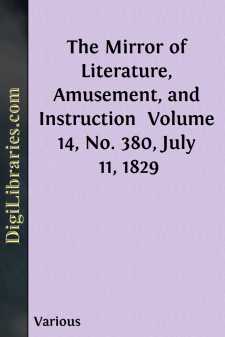Categories
- Antiques & Collectibles 13
- Architecture 36
- Art 48
- Bibles 22
- Biography & Autobiography 813
- Body, Mind & Spirit 142
- Business & Economics 28
- Children's Books 17
- Children's Fiction 14
- Computers 4
- Cooking 94
- Crafts & Hobbies 4
- Drama 346
- Education 46
- Family & Relationships 57
- Fiction 11829
- Games 19
- Gardening 17
- Health & Fitness 34
- History 1377
- House & Home 1
- Humor 147
- Juvenile Fiction 1873
- Juvenile Nonfiction 202
- Language Arts & Disciplines 88
- Law 16
- Literary Collections 686
- Literary Criticism 179
- Mathematics 13
- Medical 41
- Music 40
- Nature 179
- Non-Classifiable 1768
- Performing Arts 7
- Periodicals 1453
- Philosophy 64
- Photography 2
- Poetry 896
- Political Science 203
- Psychology 42
- Reference 154
- Religion 513
- Science 126
- Self-Help 84
- Social Science 81
- Sports & Recreation 34
- Study Aids 3
- Technology & Engineering 59
- Transportation 23
- Travel 463
- True Crime 29
The Mirror of Literature, Amusement, and Instruction Volume 14, No. 380, July 11, 1829
by: Various
Categories:
Description:
Excerpt
MERCERS' HALL, AND CHEAPSIDE
The engraving is an interesting illustration of the architecture of the metropolis in the seventeenth century, independent of its local association with names illustrious in historical record.
In former times, when persons of the same trade congregated together in some particular street, the mercers principally assembled in West Cheap, now called Cheapside, near where the above hall stands, and thence called by the name of "the Mercery." In Lydgate's London Lyckpenny, are the following lines alluding to this custom:
Then to Chepe I began me drawne,
When much people I saw for to stand;
One offered me velvet, silk and lawne
And another he taketh me by the hand.
Here is Paris thread, the finest in the land.
Pennant thus describes the principal historical data of the spot:
"On the north side of Cheapside, (between Ironmonger Lane and Old Jewry,) stood the Hospital of St. Thomas of Acon, founded by Thomas Fitz-Theobald de Helles, and his wife Agnes, sister to the turbulent Thomas Becket, who was born in the house of his father, Gilbert, situated on this spot. The mother of our meek saint was a fair Saracen, whom his father had married in the Holy Land. On the site of this house rose the hospital, built within twenty years after the murder of Thomas; yet such was the repute of his sanctity, that it was dedicated to him, in conjunction with the blessed Virgin, without waiting for his canonization. The hospital consisted of a master and several brethren, professing the rule of St. Austin. The church, cloisters, &c. were granted by Henry VIII. to the Mercers' Company, who had the gift of the mastership.
"In the old church were several monuments; among others, one to James Butler, Earl of Ormond, and Joan his wife, living in the beginning of the reign of Henry VI. The whole pile was destroyed in the great fire, but was very handsomely rebuilt by the Mercers' Company, who have their Hall here.
"In this chapel the celebrated, but unsteady, archbishop of Spalato, preached his first sermon in 1617, in Italian, before the Archbishop of Canterbury, and a splendid audience; and continued his discourses in the same place several times, after he had embraced our religion; but having the folly to return to his ancient faith, and trust himself among his old friends at Rome, he was shut up in the Castle of St. Angelo, where he died in 1625."
"The Mercers' Company is the first of the twelve. The name by no means implied, originally, a dealer in silks: for mercery included all sorts of small wares, toys, and haberdashery; but, as several of this opulent company were merchants, and imported great quantities of rich silks from Italy, the name became applied to the Company, and all dealers in silk. Not fewer than sixty-two mayors were of this Company, between the years 1214 and 1762; among which were Sir John Coventry, Sir Richard Whittington, and Sir Richard and Sir John Gresham."
The front in Cheapside, which alone can be seen, is narrow, but floridly adorned with carvings and architectural ornaments....












